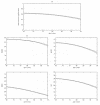Sensitivity of four psychometric tests to measure cognitive changes in brain aging-population-based studies
- PMID: 17105962
- PMCID: PMC2244646
- DOI: 10.1093/aje/kwk017
Sensitivity of four psychometric tests to measure cognitive changes in brain aging-population-based studies
Abstract
Choosing the measure of cognition in an epidemiologic study investigating cognitive changes over time is a challenging question. A powerful measure must be able to detect small cognitive changes in all the range of cognition observed in the target population. This work aims at comparing the sensitivity to detect cognitive changes in the observed range of cognition of four widely used psychometric tests in an aging-population-based study through a nonlinear latent process model, assuming that the psychometric tests are nonlinear noisy transformations of their common factor. With data from the French prospective cohort study PAQUID (1989-2001), the authors found that the Mini-Mental State Examination and the Benton Visual Retention Test exhibited a better sensitivity to cognitive changes in low levels of cognition, while the Digit Symbol Substitution Test was more sensitive to changes in high levels of cognition. In contrast, the Isaacs Set Test shortened at 15 seconds appeared to be sensitive to small changes in all the range of cognition and, thus, represents an appropriate measure of cognition in population-based studies including both highly normal and severely impaired subjects.
Figures


References
-
- Morris MC, Evans DA, Hebert LE, Bienias JL. Methodological issues in the study of cognitive decline. Am J Epidemiol. 1999;149:789–93. - PubMed
-
- Yesavage JA, Brooks JO., 3rd On the importance of longitudinal research in Alzheimer’s disease. J Am Geriatr Soc. 1991;39:942–4. - PubMed
-
- Galasko DR, Gould RL, Abramson IS, Salmon DP. Measuring cognitive change in a cohort of patients with Alzheimer’s disease. Stat Med. 2000;19:1421–32. - PubMed
-
- Dartigues JF, Commenges D, Letenneur D, et al. Cognitive predictors of dementia in elderly community residents. Neuroepidemiology. 1997;16:29–39. - PubMed
Publication types
MeSH terms
LinkOut - more resources
Full Text Sources
Medical

